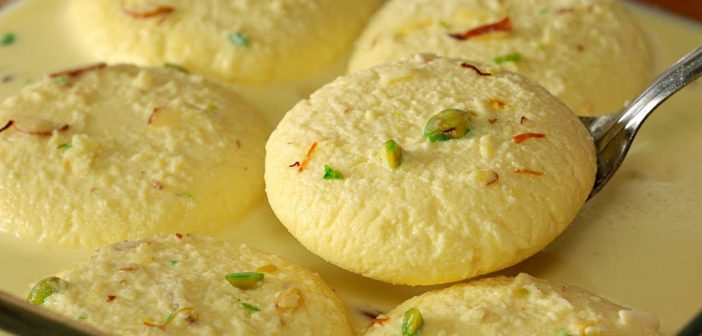Among India’s vast and vibrant dessert repertoire, Rasmalai occupies a unique space. This seemingly simple dish, with its symphony of textures and flavors, has captivated taste buds for centuries. This article delves into the world of Rasmalai, exploring its origins, the magic of its ingredients, its taste profile, and the fascinating variants that have emerged across the Indian subcontinent.
A Journey Through Time: The Uncertain Origins of Rasmalai
The exact origin of Rasmalai remains shrouded in the mists of culinary history. Some theories trace its roots back to the Mughal era, suggesting it might have been an innovation within the royal kitchens [1]. Others point towards the state of Odisha, where similar milk-based desserts like Chhena Poda have existed for centuries [2]. Regardless of its precise birthplace, Rasmalai’s journey across India has resulted in a delightful regional tapestry of variations.
The Alchemy of Ingredients: Crafting the Perfect Rasmalai
The essence of Rasmalai lies in its deceptively simple ingredients. Here’s a breakdown of the key players in this delectable dance:
- Chhena: The foundation of Rasmalai is chhena, a fresh, творо (творог – a Russian word for curd cheese) made from cow’s milk or buffalo milk. The milk is curdled with an acidic agent like lemon juice or vinegar, resulting in soft, non-grainy творо (творог).
- Sugar Syrup: The chenna balls are cooked in a light sugar syrup flavored with cardamom pods and saffron. The sugar syrup permeates the chenna balls, adding sweetness and a touch of floral aroma.
- Malai (Cream): The crowning glory of Rasmalai is the malai, a thick, flavorful cream made by reducing whole milk. This creamy layer adds richness and a contrasting texture to the soft chenna balls.
- Flavorings: Aromatic spices like cardamom and saffron play a crucial role in elevating the flavor profile of Rasmalai. Additionally, some variations might incorporate rose water or kewra water for a touch of floral essence.
A Symphony of Flavors and Textures: The Essence of Rasmalai
The magic of Rasmalai lies in its delightful interplay of textures and flavors. The chenna balls are soft and spongy, readily absorbing the sweetness of the sugar syrup. The malai, rich and creamy, provides a luxurious counterpoint. The cardamom and saffron infuse the entire dish with a subtle warmth and aroma. Each bite is a delightful dance on the palate, a testament to the simplicity and elegance of Indian desserts.
A Celebration of Regional Diversity: The Many Faces of Rasmalai
While the core concept remains the same, Rasmalai boasts a fascinating array of regional variations across India:
- Odisha’s Chhena Laddu: Odisha, a potential contender for Rasmalai’s birthplace, offers its own version called Chhena Laddu. Here, the chenna balls are slightly denser and the sugar syrup is thicker, resulting in a more fudge-like consistency.
- West Bengal’s Pantua: West Bengal’s take on Rasmalai is known as Pantua. The chenna balls are smaller and softer, and the use of kewra water adds a unique floral note to the dish.
- Maharashtra’s Shrikhand Malai Peda: Maharashtra offers a richer version called Shrikhand Malai Peda. This variation incorporates shrikhand, a strained yogurt-based dessert, into the malai layer, creating an even more decadent experience.
- Gujarat’s Malai Marwadi: Gujarat’s contribution is the Malai Marwadi. Here, the chenna balls are flavored with saffron and nuts, adding a touch of complexity to the traditional recipe.
Beyond the Plate: The Cultural Significance of Rasmalai
Rasmalai transcends its role as a mere dessert; it holds cultural significance in India. It’s often served during festivals and celebrations, symbolizing indulgence and joy. The act of sharing a plate of Rasmalai fosters a sense of community and togetherness.
A Sweet Conclusion: The Enduring Allure of Rasmalai
Rasmalai’s journey from its uncertain origins to its widespread popularity across India is a testament to its enduring allure. The simple yet evocative combination of ingredients, the symphony of textures and flavors, and the regional variations that celebrate diversity all contribute to the enduring appeal of this quintessential Indian dessert. So, the next time you encounter a plate of Rasmalai, take a moment to appreciate the artistry behind its creation and savor the delightful dance it performs on your palate.






